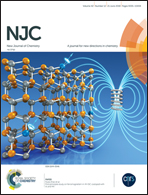A novel water soluble pillar[5]arene and phenazine derivative self-assembled pseudorotaxane sensor for the selective detection of Hg2+ and Ag+ with high selectivity and sensitivity†
Abstract
We design and synthesize a novel bifunctional supramolecular pseudorotaxane chemosensor (G-WAP), which uses water soluble cationic pillar[5]arene (WAP) as the host and a phenazine imidazole (G) as guest. The real-time fluorescence response did show efficient quenching of the supramolecular pseudorotaxane chemosensor (G-WAP) upon the addition of Ag+ and an obvious fluorescence color change of the supramolecular pseudorotaxane chemosensor (G-WAP) is observed upon the addition of Hg2+. Excellent sensitivity and selectivity toward the Hg2+ and Ag+ detection were verified in the presence of other competitive cations, and the detection limits of G-WAP for Ag+ is 1.2 × 10−8 M, for Hg2+ is 5.0 × 10−7 M. Consequently, this supramolecular pseudorotaxane chemosensor proved to be an efficient tool in the identification of mercury and silver ions in water.
![Graphical abstract: A novel water soluble pillar[5]arene and phenazine derivative self-assembled pseudorotaxane sensor for the selective detection of Hg2+ and Ag+ with high selectivity and sensitivity](/en/Image/Get?imageInfo.ImageType=GA&imageInfo.ImageIdentifier.ManuscriptID=C8NJ00508G&imageInfo.ImageIdentifier.Year=2018)


 Please wait while we load your content...
Please wait while we load your content...